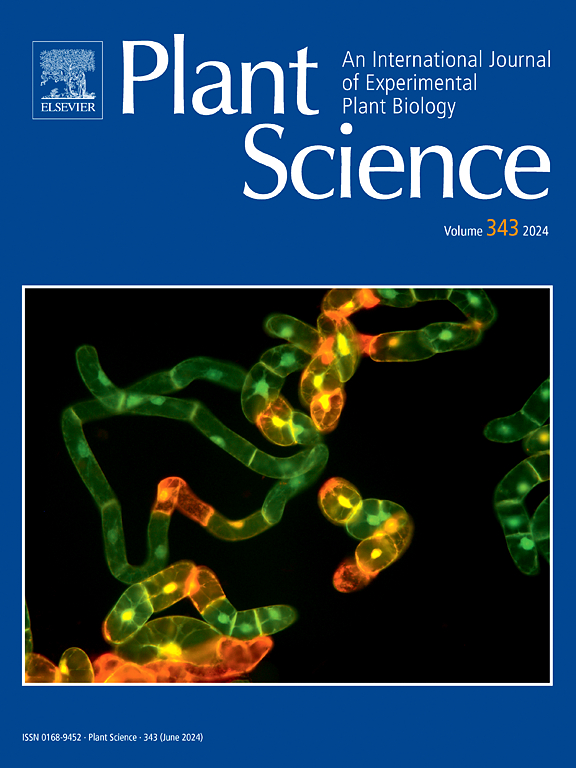Overexpression of Cordyceps militaris Cmcns1/cns2 gene to produce cordycepin results in increased resistance to Ralstonia solawacearum, Alternaria alternate and TMV in tobacco(Nicotiana tabacum L.)
IF 4.2
2区 生物学
Q2 BIOCHEMISTRY & MOLECULAR BIOLOGY
引用次数: 0
Abstract
Cordycepin (COR), the first nucleoside antibiotic isolated from fungi, exhibits antibacterial, antitumor, antiviral, and anti-inflammatory activities. In this study, we constructed a Cmcns1/cns2 fusion gene vector and transformed tobacco using Agrobacterium tumefaciens-mediated genetic transformation. The results showed that cordycepin was detected in transgenic tobacco plants, with Cmcns1/cns2 expression confirmed and the highest expression level observed in line OE1. This suggests a direct correlation between COR production and Cmcns1/cns2 gene expression levels. Importantly, following infection with viral or bacterial pathogens, the Cmcns1/cns2-overexpressing tobacco plants exhibited fewer wilting lesions compared to wild-type plants, indicating that Cmcns1/cns2 expression contributes to COR production, thereby enhancing disease resistance. We measured malondialdehyde (MDA) content, as well as superoxide dismutase (SOD) and peroxidase (POD) activity, before and after treatment. The results demonstrated that MDA content in transgenic tobacco was lower than pre-treatment levels, whereas SOD and POD activities were higher than pre-treatment values. Furthermore, expression levels of disease resistance genes NtADR1, NtNPR1, and NtNRG1 in transgenic line OE1 were significantly elevated compared to wild-type plants following treatment with Ralstonia solanacearum and Alternaria alternata. This confirms that the transgenic Cmcns1/cns2 gene enhances disease resistance in tobacco, presenting a new approach for breeding plants with improved disease resistance.
过表达蛹虫草Cmcns1/cns2基因产生冬虫夏草素,可增强烟草对茄枯病菌、交替病菌和TMV的抗性。
冬虫夏草素(Cordycepin, COR)是第一个从真菌中分离出来的核苷类抗生素,具有抗菌、抗肿瘤、抗病毒和抗炎活性。本研究构建了Cmcns1/cns2融合基因载体,利用农杆菌介导的基因转化对烟草进行转化。结果表明,在转基因烟草植株中检测到虫草素,Cmcns1/cns2均有表达,且在OE1中表达量最高。这表明COR的产生与Cmcns1/cns2基因表达水平直接相关。重要的是,在感染病毒或细菌病原体后,Cmcns1/cns2过表达的烟草植株比野生型植株表现出更少的萎蔫损伤,这表明Cmcns1/cns2的表达有助于COR的产生,从而增强抗病能力。我们测量了处理前后丙二醛(MDA)含量,以及超氧化物歧化酶(SOD)和过氧化物酶(POD)活性。结果表明,转基因烟草MDA含量低于处理前,SOD和POD活性高于处理前。此外,与野生型植物相比,转基因系OE1中抗病基因NtADR1、NtNPR1和NtNRG1的表达水平显著升高。这证实了转基因Cmcns1/cns2基因增强了烟草的抗病能力,为烟草抗病育种提供了一条新的途径。
本文章由计算机程序翻译,如有差异,请以英文原文为准。
求助全文
约1分钟内获得全文
求助全文
来源期刊

Plant Science
生物-生化与分子生物学
CiteScore
9.10
自引率
1.90%
发文量
322
审稿时长
33 days
期刊介绍:
Plant Science will publish in the minimum of time, research manuscripts as well as commissioned reviews and commentaries recommended by its referees in all areas of experimental plant biology with emphasis in the broad areas of genomics, proteomics, biochemistry (including enzymology), physiology, cell biology, development, genetics, functional plant breeding, systems biology and the interaction of plants with the environment.
Manuscripts for full consideration should be written concisely and essentially as a final report. The main criterion for publication is that the manuscript must contain original and significant insights that lead to a better understanding of fundamental plant biology. Papers centering on plant cell culture should be of interest to a wide audience and methods employed result in a substantial improvement over existing established techniques and approaches. Methods papers are welcome only when the technique(s) described is novel or provides a major advancement of established protocols.
 求助内容:
求助内容: 应助结果提醒方式:
应助结果提醒方式:


